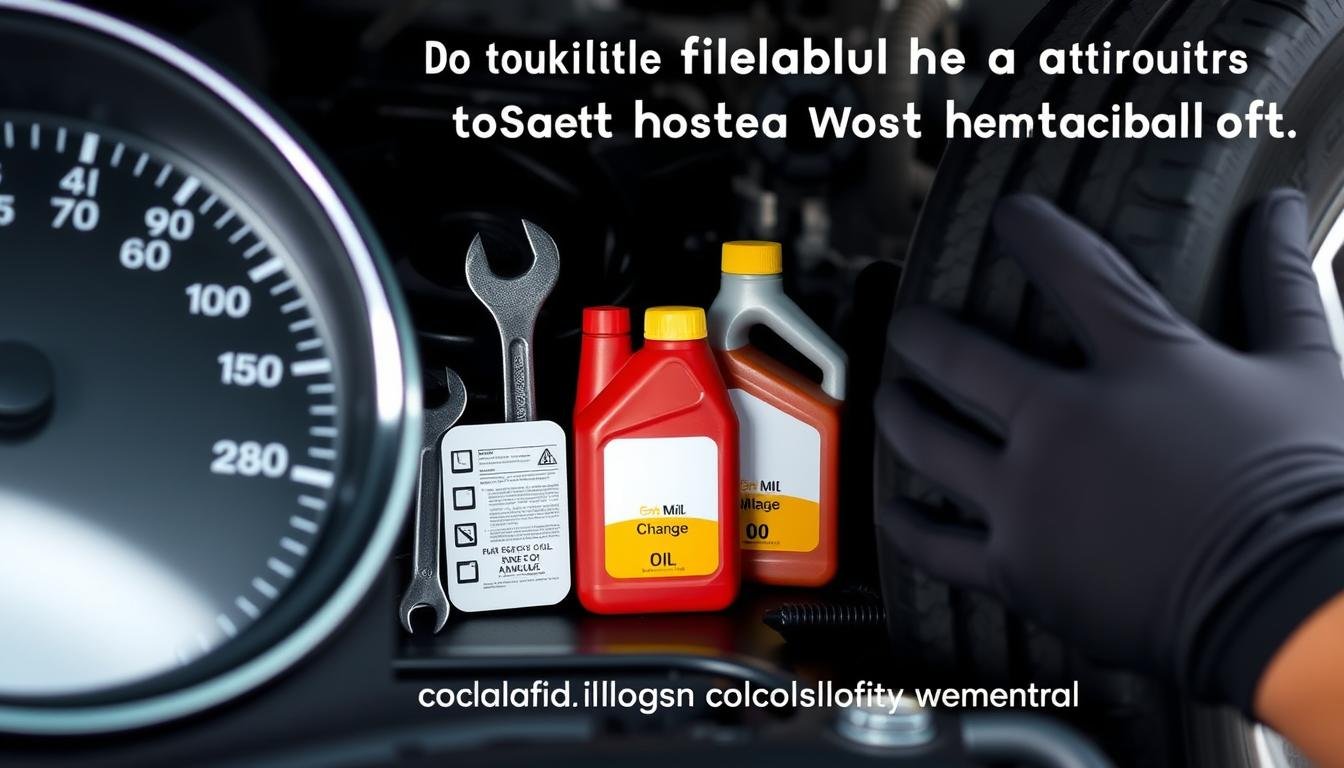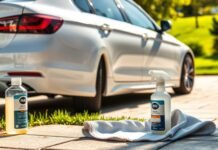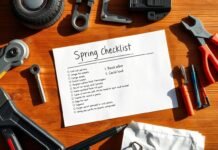Drive It Longer: How to Extend the Life of Your Vehicle Without Breaking the Bank
Your car can last for years with the right care. Even older cars do well with regular maintenance. This guide will show you how to keep your car running well with simple steps.
Follow an oil change routine and tire rotation schedule. Focus on keeping your engine in good shape and save money. You’ll keep your car safe and reliable without spending a lot.
Key Takeaways
- Stick to an oil change routine every 3,000–5,000 miles to prevent engine damage.
- Check tire pressure weekly and follow a tire rotation schedule every 6,000 miles.
- Use a car maintenance checklist to track fluids, brakes, and other critical systems.
- Smooth driving habits reduce strain, helping extend your car’s lifespan without extra costs.
- Regular checkups catch small issues early, avoiding costly repairs and ensuring safety.
Understanding the Basics of Car Maintenance
Regular maintenance keeps your car reliable and safe. Simple tasks like checking fluids or replacing filters are key. They help keep costs down and performance up, letting you keep car running longer. Follow these car care tips to extend your vehicle’s life.
What Constitutes Regular Maintenance
Routine tasks are the heart of car upkeep advice. These include:
- Oil changes every 3,000-5,000 miles
- Tire pressure checks monthly
- Brake system inspections annually
- Battery and belt checks twice yearly
Key Car Fluids To Monitor
Fluids protect vital systems. Keep an eye on these regularly:
| Fluid | Purpose | Maintenance Tip |
|---|---|---|
| Engine Oil | Lubricates engine parts | Replace every oil change to protect engine life |
| Coolant | Prevents overheating | Check color and level every 6 months |
| Brake Fluid | Activates brakes | Test moisture content yearly |
Benefits of Routine Checkups
Routine inspections save money and extend lifespan. Benefits include:
- Increase car mileage by 10-15% through optimized performance
- Early detection of issues like worn brakes or clogged filters
- Extends engine longevity by 30-50% (AAA, 2023)
“Regular checkups turn small fixes into big savings.” – ASE Certified Mechanic, National Institute for Automotive Service Excellence
Small steps like these are the foundation of driving habits for longevity. Start today to see results.
Essential Oil Change Routine
Regular oil changes are key to your engine’s health. By following this routine, you can extend engine life and how to avoid costly car repairs. Skipping oil changes can lead to sludge buildup, which strains your engine and shortens its life.
- Check oil level monthly using the dipstick. Wipe it clean, reinsert, and pull again to get an accurate reading.
- Use the manufacturer’s recommended oil type. For many vehicles, SAE 5W-30 works well in varying climates.
- Never overfill. Excess oil causes pressure spikes, damaging seals and pistons.
Stick to your car’s manual schedule—even if it says “full synthetic.” Overdue changes cost more in the long run. Always recycle old oil at service stations for eco-friendly car maintenance savings.
- Pair oil changes with a quick check of other fluids (coolant, brake fluid) for fluid top-up tips that keep car in good condition.
- Replace the oil filter every change to trap debris and how to make car last longer.
Ignoring oil maintenance cuts prolong car life chances. A clean engine means smoother performance and fewer breakdown risks. Protect your investment with this simple habit today.
Maintaining Tire Health: Pressure, Rotation and More
Your tires are the only points of contact between your car and the road. Taking care of them ensures safety, boosts fuel efficiency, and avoids expensive repairs. Follow these tire care tips to keep your vehicle running smoothly as part of vehicle upkeep 101.
Regular tire rotations can extend tread life by up to 20%, according to the Rubber Manufacturers Association.
Tire Pressure Best Practices
Check tire pressure monthly using a gauge. Underinflated tires can cause avoid car breakdowns and cut gas mileage by 3%. Here’s how:
- Use the PSI number on your car’s door sticker, not the tire sidewall.
- Test tires when cold (before driving 1 mile).
- Adjust for seasons: increase pressure slightly in summer heat to prevent overheating.
Effective Tire Rotation Strategies
Rotate tires every 5,000–7,000 miles to ensure even wear. Follow these steps:
- Use patterns like front-to-back or X-pattern rotations.
- Check alignment during rotation to correct drifting or uneven tread.
- Incorporate winter car care by inspecting tires before snowy seasons.
Pair rotations with summer car maintenance inspections for tread depth and sidewall damage. These steps are vital vehicle reliability tips that save money and extend tire lifespan. Prioritizing these steps during regular car inspections ensures your car stays safe and reliable year-round.
Caring for Filters and Fluids
Keeping your car’s filters and fluids in good shape is essential. It helps your car last longer and saves money on repairs. If you ignore these, your car might fail early. Regular checks and using quality parts protect your engine and save you money. Follow these steps to make your car last longer and run better.
Air Filter Replacement Tips
- Replace every 15,000–30,000 miles or as your manual advises. A clogged filter strains the engine, reducing performance.
- Choose quality parts like OEM filters to ensure clean airflow. This prevents costly engine damage and improves fuel efficiency.
Fluid Top-Up Techniques
Check engine coolant, brake fluid, and transmission fluid monthly. Low coolant can overheat the engine, while insufficient brake fluid impacts brake system care. Use fluids specified by your manufacturer. Top up when levels are low to avoid damage.
Importance of Engine Oil Quality
Choose oil with the recommended viscosity for your engine. Inferior oil can leave deposits, causing wear over time. Regular changes with quality car parts prevent sludge buildup. Clean engine tips include using high-quality oil to keep internals clean and running smoothly.
Pair these practices with regular vehicle service and car battery tips to ensure your car stays reliable. Proper maintenance through this guide helps you avoid costly repairs and extends its lifespan.
Developing Gentle Driving Habits
Driving style is key in how to care for old car models. Sudden starts and hard braking put a lot of stress on the engine and transmission. This makes it important to prevent wear and extend engine life.
Every time you start slowly and avoid heavy braking, you help your car’s parts last longer. This reduces the wear and tear on moving parts.
- Accelerate slowly to protect your transmission and cut fuel waste.
- Anticipate stops to avoid abrupt braking, preserving brake pads and hydraulic systems.
- Shift gears smoothly if driving a manual, preventing clutch wear.
Aggressive driving can reduce fuel efficiency by up to 33% at highway speeds, according to the U.S. Department of Energy.
Smarter driving habits also improve your car’s performance over time. Slow speed changes and steady speeds help improve fuel economy tips and lower repair costs. Even older cars benefit from calm driving, as shown in vehicle maintenance guide by Toyota or Ford.
These habits are not just about saving gas. They’re an investment in your car’s long-term reliability. Small changes like coasting to stops or avoiding idling lead to fewer mechanical issues. Your car will run smoother and have fewer breakdowns.
How to Extend the Life of Your Vehicle
Extending your car’s lifespan starts with small choices. By blending daily driving tips with long-term car care, many owners reach milestones like how to get 200k miles. Experts say that mindful habits and consistent upkeep are key. Here’s how to make routine actions last longer.
Understanding the Impact of Driving Style
Your driving habits affect your car’s health. Aggressive driving or short trips can wear out parts quickly. Instead:
- Avoid sudden stops and starts to reduce wear on brakes and transmission
- Drive steadily at highway speeds to cut engine stress
- Plan routes to minimize idling and cold-start wear
Scheduling Preventative Maintenance
Regular car service intervals are essential. Use vehicle maintenance apps like RepairPal or Carvoy to track important services. Add DIY car care basics:
- Check tire pressure monthly using a gauge
- Wash undercarriages seasonally to prevent corrosion
- Use a car cleaning for longevity approach with pH-balanced products
By following these steps, you build vehicle durability without expensive repairs. Small changes today mean fewer problems tomorrow. Proactive choices lead to a longer-lasting vehicle.
Following a Consistent Maintenance Schedule
Keeping your car in top shape is more than just fixing it now and then. It needs a regular routine. A fluid replacement guide and picking the right best engine oil type are key. Regular checks, like when to replace spark plugs and vehicle underbody care, keep everything running smoothly.
- Use a fluid replacement guide to track coolant, brake, and transmission fluid levels.
- Replace spark plugs as advised in your manual to avoid engine misfires.
- Choose the best engine oil type for your engine’s needs to reduce wear.
| Task | Recommended Interval |
|---|---|
| Spark Plug Replacement | Every 30,000–50,000 miles |
| Engine Oil Change | Every 5,000–7,500 miles |
| Car wax and paint protection | Every 6 months |
| Vehicle storage tips | Before long-term parking |
| Keep car rust-free | Monthly inspections |
“A consistent schedule prevents 70% of avoidable repairs,” says AAA. Protect your car’s exterior by washing undercarriages and applying wax. For long-term storage, use vehicle storage tips like tire lifts and moisture absorbers.
Use apps like Car Care Pro or a physical logbook to track deadlines. Small steps like these turn routine care into a shield against costly surprises. Stick to your plan, and your vehicle will reward you with reliability.
Proactive Checkups and Early Issue Detection
Keeping your car in top shape starts with catching small problems early. Regular checks and a vehicle service log help spot issues before they get worse. Here’s how to stay on top of it:
Identifying Warning Signs Early
Regularly check under the hood for coolant top-up needs or brake fluid check levels. Look for leaks, corrosion, or worn parts. Replacing the cabin air filter every 15,000 miles keeps the air clean. Use this checklist for your routine:
| Check Item | Frequency |
|---|---|
| Transmission fluid check | Every 30,000 miles |
| Power steering fluid guide levels | Monthly |
| Battery maintenance | Quarterly |
Using a Vehicle Service Log
Keep track of clean car battery terminals and avoid hard braking in your log. Note any dashboard warnings, fluid levels, and performance changes. For example:
- Date and mileage of last transmission fluid check
- Notes on brake fluid check clarity and levels
“Early detection saves up to 40% in repair costs by addressing issues before system failures.” – Automotive Research Council
By following these steps and checking the power steering fluid guide regularly, you can prevent big problems. Small actions can make a big difference. Stay proactive, and your car will last longer and run better.
Quality Parts and Upgrade Considerations
Choosing quality parts and timely upgrades keeps your vehicle running smoothly. High-quality components like premium brake pads or engine oil protect critical systems. Here’s how to prioritize upgrades without overspending:
- Use gentle acceleration tips to reduce engine strain, pairing with premium parts for better performance.
- Always avoid overloading car weight limits to prevent stress on suspension and drivetrain parts.
- Invest in tires with deep tread and schedule regular alignment checks to ensure even maintain tire tread health.
- Protect your engine by using a fuel system cleaner to keep clean fuel injectors free of deposits.
- Track maintenance progress with a vehicle service log to spot upgrade needs early.
“Upgrading to quality parts early can cut repair costs by 30% over time,” says AAA’s automotive research.
Stick to manufacturer-approved components or trusted brands for longevity. A vehicle service log helps track when parts like brakes or filters need replacing. Prioritizing these steps ensures your car stays reliable and retains value.
Protecting Your Car Against Extreme Weather
Expert advice stresses the importance of seasonal adjustments—such as specific wax treatments in summer and rust prevention in winter—to protect your vehicle’s exterior and mechanical components.
Extreme heat and cold can harm your car’s paint, battery, and fluids. Follow these car tlc tips to protect your investment and increase trade-in value. Start by checking your service manual to find out when to service car parts exposed to weather. Here’s how to prepare for each season:
Summer Car Care Essentials
- Apply a high-quality carnauba wax to protect paint from UV rays—this car care for new drivers shields against fading.
- Check tire pressure weekly. Hot roads expand tires; underinflation leads to blowouts.
- Park in shaded areas to prevent dashboard cracks. Use sunshades to keep interiors cool.
Winter Maintenance Strategies
- Wash your car frequently to remove salt and road grime that cause rust. Rinse undercarriages after snowstorms.
- Use winter-grade oil and first-time owner tips like checking coolant levels to prevent engine freeze.
- Test battery health every autumn. Cold drains battery power faster.
| Summer Focus | Winter Focus |
|---|---|
| Wax application | Salt removal washes |
| Tire pressure checks | Antifreeze testing |
| Interior cooling methods | Battery maintenance |
Regular used car maintenance during seasons preserves vehicle resale value. Follow manufacturer guidelines in your service manual to time when to service car systems. Small steps now mean fewer costly repairs later.
Avoiding Unnecessary Idling and Reducing Wear
Idling your engine for too long puts stress on your car’s systems. Modern engines warm up quickly when moving, even in cold weather. Idling wastes fuel and causes damage to engine parts.
Used car maintenance and new car care routine both benefit from less idling.
Idling for more than 30 seconds wastes fuel and accelerates engine wear. Turn it off at long stops like school zones or drive-thrus.” – AAA Automotive Research
- Turn off the engine at stops lasting over a minute
- Plan routes to avoid traffic circles with frequent stops
- Use parking lots instead of waiting in line at curbside services
Drive safe and smart by not believing idling protects engines. Idling for too long can stress engine parts. Treat your vehicle with mechanical sympathy by shifting into gear sooner when traffic starts moving. Drive to preserve your car’s longevity by avoiding revving at stoplights or sudden accelerations.
Make these steps part of your preventive maintenance car plan. Reducing idle time saves money and lowers emissions. Small changes like these help keep your vehicle reliable for years.
Maximizing Mileage through Efficient Upkeep
Small changes in your car care routine can greatly improve fuel efficiency. Regular checks like engine health check and regular diagnostics help your car go further on each gallon. Even cars with low mileage maintenance needs should have car belts and hoses checked to avoid losing efficiency.
Tips for Better Fuel Economy
- Check tire pressure monthly—underinflated tires waste up to 3% of fuel, per the EPA.
- Respond to check engine light alerts promptly; sensors often flag issues like clogged filters that hurt mileage.
- Replace car belts and hoses at recommended intervals to prevent power-robbing leaks or cracks.
- Use the right oil grade for your engine to reduce internal friction and strain.
Long-Term Benefits of Preventative Care
Maintaining older vehicles through budget-friendly car care extends their life. Regular checks like engine health check prevent expensive repairs. A well-maintained car also holds its value better, making it a smart choice over time.
“Preventative care adds 10-15% to a vehicle’s lifespan when done consistently.” – National Institute for Automotive Maintenance
Every oil change and belt inspection is an investment. By focusing on these steps, you make routine tasks into fuel-saving strategies. Regular diagnostics protect your wallet and keep your car running efficiently for years.
DIY Car Care and Repairs
Many routine tasks to keep car reliable can be done at home. Start with simple checks like inspecting car belts and hoses monthly. A quick engine health check takes minutes—just look for cracks or leaks. Even drivers with low mileage maintenance needs can benefit from basic upkeep.
- Wash your car monthly to protect car paint from road grime.
- Use a garage to shield your vehicle from elements, following garage parking tips like aligning wheels straight to avoid tire wear.
- Watch for potholes! Slow down over rough roads to avoid potholes damaging suspension.
| DIY Tasks | Professional Tasks |
|---|---|
| Replacing cabin air filters | Timing belt replacement |
| Cleaning battery terminals | Engine diagnostics |
| Checking tire tread depth | Transmission flush |
Start with small projects. For example, applying wax every six months shields paint better than neglect. Always refer to your owner’s manual for steps. If unsure, consult online guides from brands like AutoZone or Pep Boys. Remember: consistent low mileage maintenance extends vehicle lifespan without high costs.
Budget-Friendly Car Maintenance Tips
Keeping your car in good shape doesn’t have to cost a lot. Budget-friendly car care is all about making small changes that add up. Regular checks and smart choices can save you money and keep your car running well.
“Ignoring small issues costs drivers an average of $500+ annually.” —AAA Foundation for Traffic Safety
Cost-Saving Maintenance Hacks
Here are some simple tips to start with:
- Don’t ignore the check engine light. A basic scan tool costs under $30 and can prevent bigger problems.
- Check your car fluids explained in your manual every month. Low coolant or oil can damage your engine.
- For maintaining older vehicles, replace belts and hoses during routine checks. This avoids expensive repairs later.
| Smart Habit | Money Saved |
|---|---|
| Regular diagnostics | Avoid $500+ transmission repairs |
| Check engine light response | Prevent $1,000+ engine damage |
Investing in Quality Over Quantity
Choose parts that will last longer. For example:
- Use OEM or name-brand filters—they cost 15% more but last twice as long.
- Extend hybrid car life by picking certified batteries over cheaper ones.
- Driving for efficiency—smooth driving saves 15% on fuel, saving $300+ a year.
Small choices today can prevent big problems tomorrow. Start with a regular diagnostics checklist. Your wallet and your car will appreciate it.
Conclusion
Keeping your car running for a long time starts with simple steps. Regular maintenance, like oil changes and tire rotations, is key. Also, avoid idling too long and use quality fuel instead of cheap gas. This protects your engine.
Follow the schedule for when to change your timing belt. Sticking to this schedule helps your car last longer. Taking care of your car’s interior, like cleaning seats and using protectants, also adds value.
These small actions can save you money and keep your car reliable. By making maintenance a habit, you can enjoy a dependable ride without extra costs. Drive smart and maintain regularly to make your car last for years.
FAQ
How often should I change my vehicle’s oil?
Change your oil every 5,000 to 7,500 miles. Always check your owner’s manual for specific guidelines.
What are the key fluids I need to monitor in my car?
Watch your engine oil, coolant, brake fluid, transmission fluid, and power steering fluid. Regular checks can prevent expensive repairs.
How can I tell if my tires need rotation?
Look for uneven wear, changes in handling, or a mileage indicator (every 5,000 to 8,000 miles). These signs mean your tires need rotation.
What should I do if I notice a warning light on my dashboard?
Don’t ignore warning lights. Check your owner’s manual for meanings. Then, take action, like checking fluids or scheduling a service.
How do I know when to replace my air filter?
Replace your air filter every 15,000 to 30,000 miles. But, do it sooner in dusty areas or if your engine performance drops.
What is the best way to check tire pressure?
Use a reliable tire pressure gauge on cold tires. Pressure increases with heat from driving.
Why is gentle driving important for my vehicle?
Gentle driving reduces wear on your engine and transmission. It helps your vehicle last longer.
How can I keep track of my vehicle’s maintenance schedule?
Use a vehicle maintenance app or a simple log. Record service dates and reminders for oil changes and other tasks.
What are the benefits of using high-quality car parts?
High-quality parts offer better performance, reliability, and a longer lifespan. They also mean fewer repairs.
How do I prepare my car for winter conditions?
Wash your car to remove road salt. Check your tires’ tread and top up antifreeze and windshield wiper fluids.
What are some DIY car maintenance tasks I can perform?
You can check and top off fluids, replace air filters, and clean battery terminals. These are basic tasks.
How can I maximize my fuel economy?
Keep your tires inflated, maintain your engine, and avoid idling. These steps improve fuel efficiency.




















